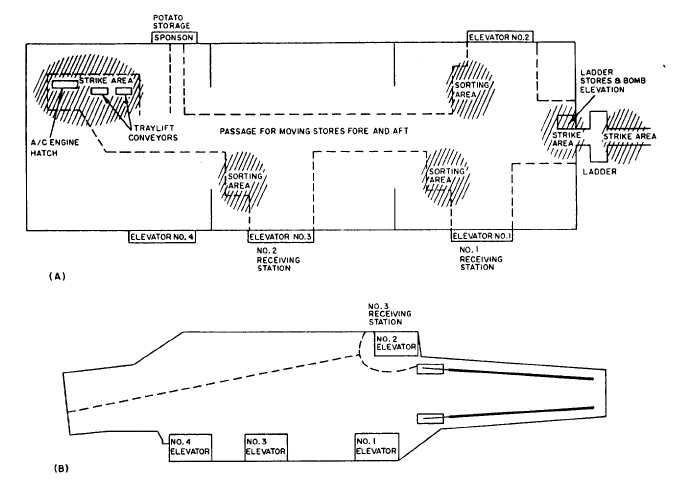| |
Figure 7-1.—Carrier deck plans (A) hangar deck; (B) flight deck.
replenishment) until the nets are detached from
the transfer rig at the receiving station. At that
moment the stores become the responsibility of
the supply department. They must be removed
from the receiving station as quickly as possible.
The time interval available is the time required
for the hook to travel to the transferring ship, pick
up a loaded net, and return—a matter of
moments. Material received by helicopter must
be moved into position on the elevator quickly
and the elevator promptly lowered to the hangar
deck, cleared of stores, and promptly raised to
the flight deck for the next load.
SORTING STATIONS.— The second group
is composed of the sorting or segregation stations,
where the material is separated by type and
storage destination. These stations may be located
at any point, depending upon local conditions.
Sorting necessarily requires a fair amount of
space, especially since there may be temporary
delays while unit loads of one item are assembled.
The main consideration in assigning locations for
sorting stations must be that no time or effort is
wasted. If the storerooms are located in other
parts of the ship, sorting must be done on the
hangar deck. Material received by helicopter on
the flight deck is usually shunted promptly to a
hangar deck sorting station.
Some ships are designed so that foodservice
storerooms are accessible from the messdeck. On
these ships, provisions may be shunted directly
below to the messdeck before sorting.
STRIKE STATIONS.— The strike stations,
the third group, are the access hatches where the
material is moved below decks. Included in this
group are the ammunition
where pallets are lowered
and hatches where material
hand by sliding on board or
or belts.
elevators, hatches
by electric hoists,
is passed down by
down metal chutes
7-11
|

